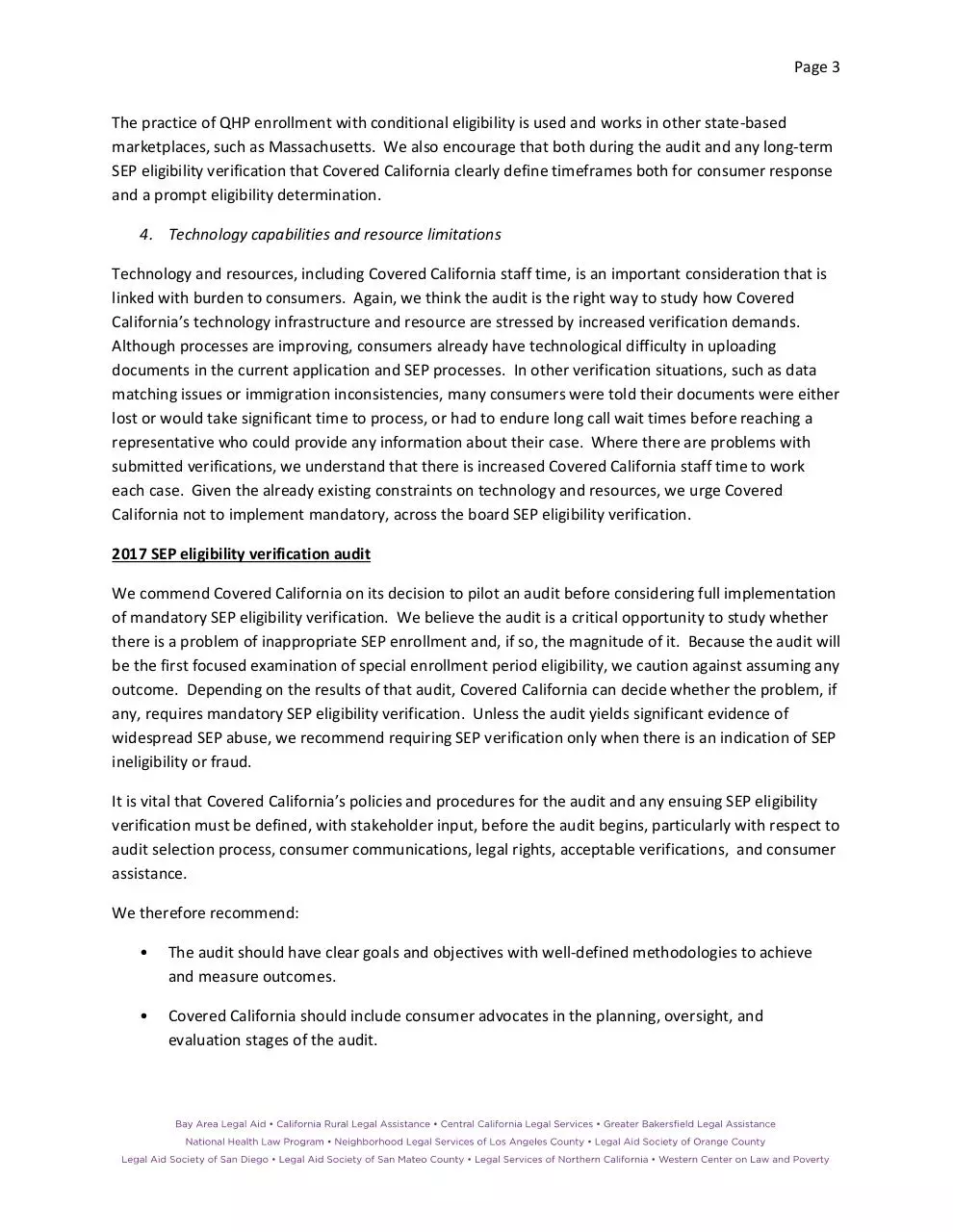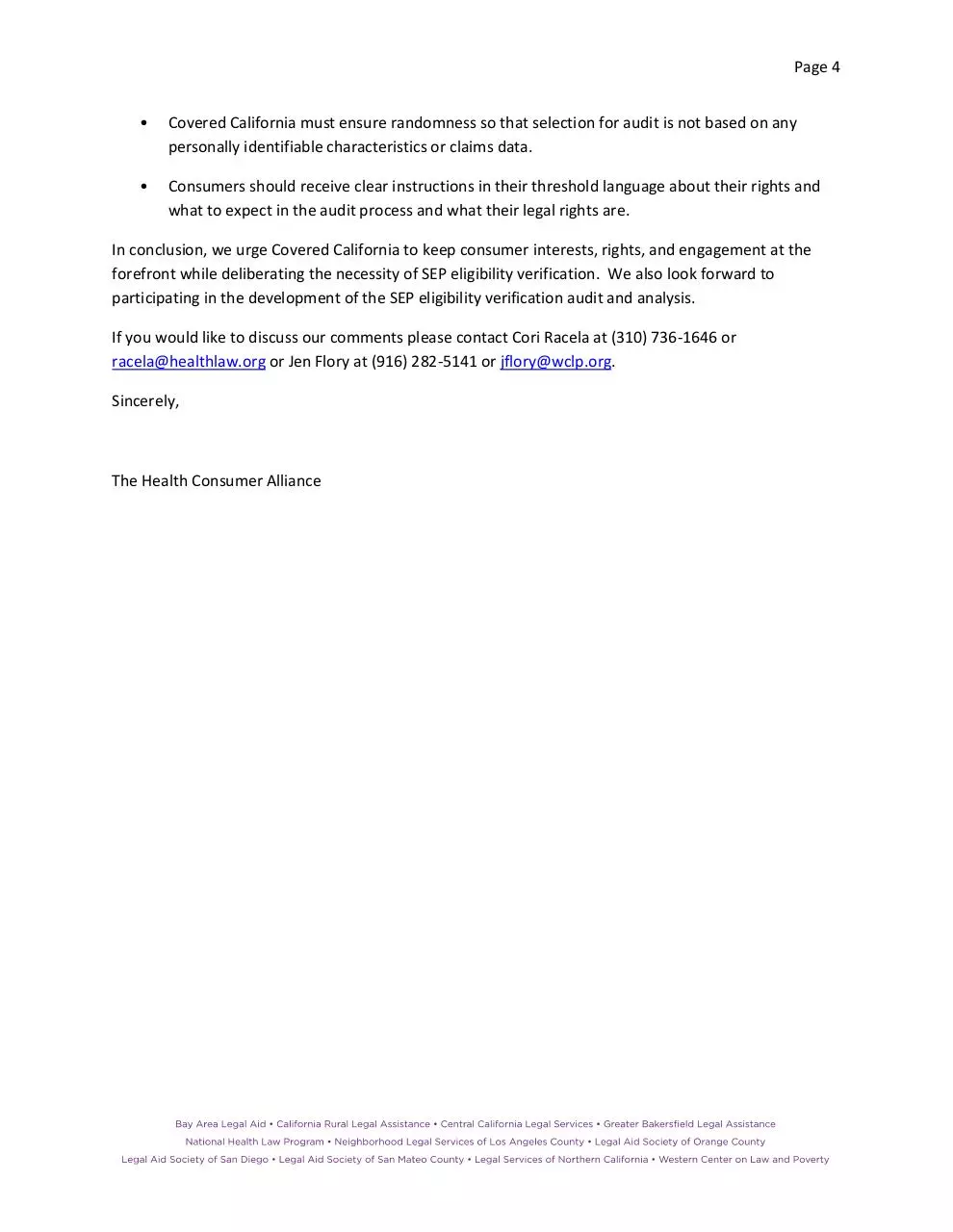HCA letter to Covered CA Board (PDF)
File information
Author: Cori Racela
This PDF 1.5 document has been generated by Microsoft® Word 2010, and has been sent on pdf-archive.com on 31/08/2016 at 20:52, from IP address 50.76.x.x.
The current document download page has been viewed 330 times.
File size: 462.79 KB (4 pages).
Privacy: public file




File preview
April 5, 2016
Ms. Diana Dooley, Chair
Paul Fearer
Genoveva Islas
Marty Morgenstern
Art Torres
Covered California Board
Via email to boardcomments@covered.ca.gov
Dear Covered California Board Members:
We write to you regarding the proposed Special Enrollment Policy verification regulations and planned
audit. The Health Consumer Alliance has been the designated statewide independent consumer
assistance program since before the first open enrollment. Through our individual and policy advocacy
with Covered California consumers we have gained valuable insight into the consumer experience.
As our testimony at the last Board meeting indicated, our work with consumers has shown that
additional verification requirements are a tremendous burden on low- and moderate-income
Californians and are a substantial barrier on health care access, even for eligible persons. Mandatory
SEP verification would be a significant burden on consumers and a workload and technology strain for
Covered California. We commend Covered California for taking the interim step of auditing SEP
eligibility in the coming year but we caution against any hasty implementation of policies or procedures
that would deprive eligible applicants and enrollees access to health care.
To that end, we provide the following comments on the proposed guiding principles and audit process
for SEP eligibility verification.
Proposed Special Enrollment Policy Guiding Principles
1. Integrity of the market risk mix and long term affordability
We believe that in order to keep consumer engagement and trust high while preserving affordability,
any SEP eligibility verification should be narrowly targeted only to instances of suspected ineligibility or
fraud and should use electronic verification rather than requiring paper documentation. While we
understand the balance Covered California must strike between plans and consumers to achieve
affordability, we believe that mandatory SEP eligibility verification will have a chilling effect. Excessive
documentation requests may be a deterrent to potentially eligible Covered California applicants who
may spread the risk and Covered California should take care not to discourage participation. Problems
and consumer frustration with the verification process already exist—such as lost documents, trouble
Page 2
uploading verifications, incorrect eligibility results, confusing notices, long call center wait times, and
difficulty resolving issues. Adding another level of verification may jeopardize the integrity of the
market mix by increasing consumer distrust and decreasing engagement with Covered California. At the
same time, mandatory SEP eligibility verification will be time consuming and costly for both consumers
and Covered California administration.
2. SEP Policy will not be overly burdensome to members
We commend Covered California for prioritizing minimal burden to Covered California applicants and
enrollees. We also agree that electronic verification should be maximized, where available, and that
Covered California should accept a wide range of documentation to support SEP eligibility. We urge
Covered California to preserve its current practice and enumerated principle of always accepting
attestation—whether it is in the first instance or as a last resort. The ability to attest to SEP eligibility
may be the only viable method for consumers who have difficulty accessing documents, especially for
consumers who are limited English proficient or who are in circumstances that make document
acquisition nearly impossible, such as for domestic violence survivors, seasonal workers, those losing
jobs, for those having to move in with other family members or experiencing homelessness, and for
those experiencing displacement because of natural disaster or environmental hazards.
We believe the audit offers an opportunity for Covered California to study how consumers respond to
notices, what documents consumers are able or unable to provide, what consumers need to attest to,
and, perhaps most importantly, what types of and how much consumer assistance is necessary to verify
SEP eligibility.
A policy of mandatory verification would be highly burdensome to consumers and to the Covered
California staff required to obtain and process such verification, and we reiterate that to the extent that
SEP eligibility is indeed an issue, verification requirements should be targeted only to cases where fraud
or other ineligibility is expected.
3. SEP eligibility is conditionally granted to not jeopardize access to care
The consideration for access to care is paramount and we commend Covered California for including it
among the four guiding principles. It is critical that Covered California allow conditional eligibility and
plan enrollment while SEP eligibility verification is pending.
For some special enrollment qualifying events, it can take time to get the documents that demonstrate
the event, for example records that must be requested from another state. This should not preclude
eligible people from enrolling in the meantime.
The ACA only allows one short gap in coverage before levying penalties. For some people, this means
not only will they be unable to access care while waiting to get documents to show they are eligible for
special enrollment, they will also incur a tax penalty if they cannot enroll first and verify later.
Page 3
The practice of QHP enrollment with conditional eligibility is used and works in other state-based
marketplaces, such as Massachusetts. We also encourage that both during the audit and any long-term
SEP eligibility verification that Covered California clearly define timeframes both for consumer response
and a prompt eligibility determination.
4. Technology capabilities and resource limitations
Technology and resources, including Covered California staff time, is an important consideration that is
linked with burden to consumers. Again, we think the audit is the right way to study how Covered
California’s technology infrastructure and resource are stressed by increased verification demands.
Although processes are improving, consumers already have technological difficulty in uploading
documents in the current application and SEP processes. In other verification situations, such as data
matching issues or immigration inconsistencies, many consumers were told their documents were either
lost or would take significant time to process, or had to endure long call wait times before reaching a
representative who could provide any information about their case. Where there are problems with
submitted verifications, we understand that there is increased Covered California staff time to work
each case. Given the already existing constraints on technology and resources, we urge Covered
California not to implement mandatory, across the board SEP eligibility verification.
2017 SEP eligibility verification audit
We commend Covered California on its decision to pilot an audit before considering full implementation
of mandatory SEP eligibility verification. We believe the audit is a critical opportunity to study whether
there is a problem of inappropriate SEP enrollment and, if so, the magnitude of it. Because the audit will
be the first focused examination of special enrollment period eligibility, we caution against assuming any
outcome. Depending on the results of that audit, Covered California can decide whether the problem, if
any, requires mandatory SEP eligibility verification. Unless the audit yields significant evidence of
widespread SEP abuse, we recommend requiring SEP verification only when there is an indication of SEP
ineligibility or fraud.
It is vital that Covered California’s policies and procedures for the audit and any ensuing SEP eligibility
verification must be defined, with stakeholder input, before the audit begins, particularly with respect to
audit selection process, consumer communications, legal rights, acceptable verifications, and consumer
assistance.
We therefore recommend:
•
The audit should have clear goals and objectives with well-defined methodologies to achieve
and measure outcomes.
•
Covered California should include consumer advocates in the planning, oversight, and
evaluation stages of the audit.
Page 4
•
Covered California must ensure randomness so that selection for audit is not based on any
personally identifiable characteristics or claims data.
•
Consumers should receive clear instructions in their threshold language about their rights and
what to expect in the audit process and what their legal rights are.
In conclusion, we urge Covered California to keep consumer interests, rights, and engagement at the
forefront while deliberating the necessity of SEP eligibility verification. We also look forward to
participating in the development of the SEP eligibility verification audit and analysis.
If you would like to discuss our comments please contact Cori Racela at (310) 736-1646 or
racela@healthlaw.org or Jen Flory at (916) 282-5141 or jflory@wclp.org.
Sincerely,
The Health Consumer Alliance
Download HCA letter to Covered CA Board
HCA letter to Covered CA Board.pdf (PDF, 462.79 KB)
Download PDF
Share this file on social networks
Link to this page
Permanent link
Use the permanent link to the download page to share your document on Facebook, Twitter, LinkedIn, or directly with a contact by e-Mail, Messenger, Whatsapp, Line..
Short link
Use the short link to share your document on Twitter or by text message (SMS)
HTML Code
Copy the following HTML code to share your document on a Website or Blog
QR Code to this page

This file has been shared publicly by a user of PDF Archive.
Document ID: 0000478886.